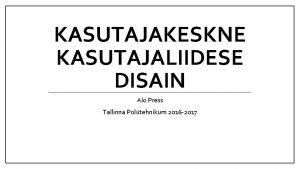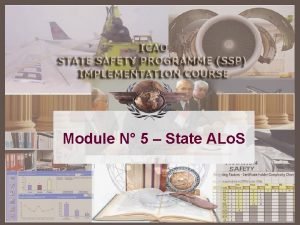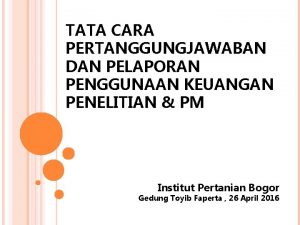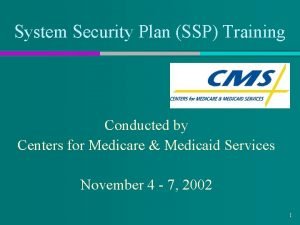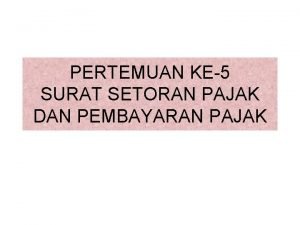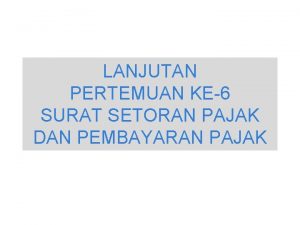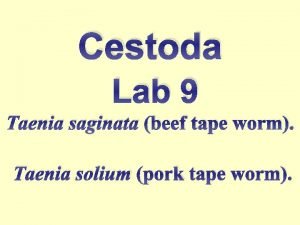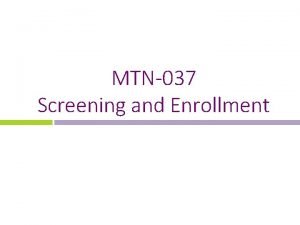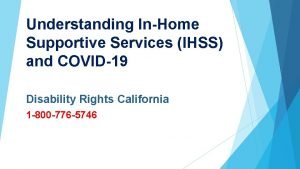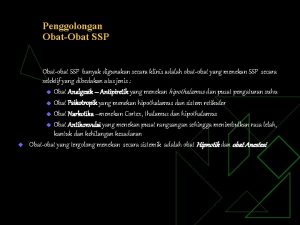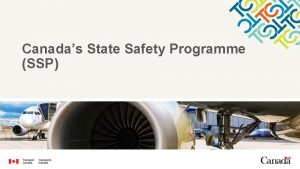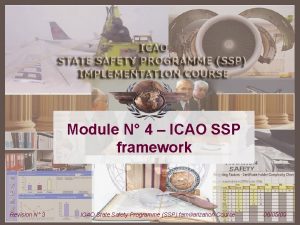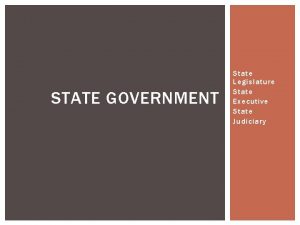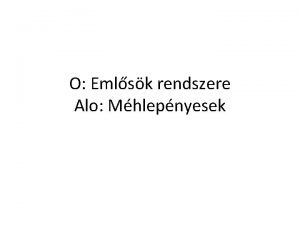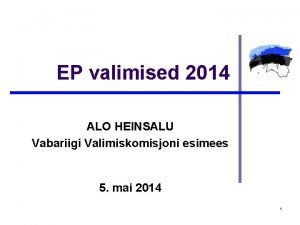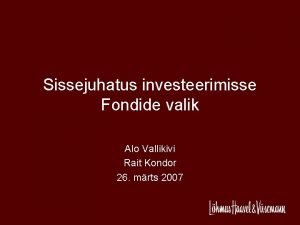Module N 5 State ALo S SSP A








![Introductory concepts – The basic theory: examples Value of safety indicators 1. [Rate/number] Fatal Introductory concepts – The basic theory: examples Value of safety indicators 1. [Rate/number] Fatal](https://slidetodoc.com/presentation_image_h/05acaeda7b0a50476d424c946937f18c/image-9.jpg)
















- Slides: 25

Module N° 5 – State ALo. S

SSP – A structured approach Module 7 SSP training programme Module 8 SSP familiarization plan Module 4 ICAO SSP framework Module 5 State ALo. S Module 1 Introduction to the SSP familiarization course Module 2 Basic safety management concepts Module 6 Prescription / Performance based environment Module 3 ICAO SARPs related to safety management

Objective v At the end of this module, participants will be familiar with the concepts and dimensions underlying the acceptable level of safety (ALo. S) related to an SSP

Contents v Introductory concepts v Acceptable level of safety (ALo. S) v ALo. S related to an SSP v Summary v Questions

Introductory concepts v The development and implementation of ALo. S builds upon certain basic concepts of systems theory v There is a hierarchy underlying the progression of these basic concepts towards the development and implementation of ALo. S v Understanding of the concepts and hierarchy is an essential foundation for the development and implementation of ALo. S and the SSP

Introductory concepts – The basic theory 1. Safety – as defined by Doc 9859 2. Level of safety – degree of safety of a system, representing the quality of the system, safetywise, expressed through safety indicators 3. Safety indicators – parameters that characterize and/or typify the level of safety of the system 4. Safety targets – concrete objectives to be achieved 5. Acceptable level of safety – minimum degree of safety that must be assured by a system in actual practice 6. Value of a safety indicator – quantification of

Introductory concepts – Selection of safety indicators v The selection of appropriate safety indicators is an essential foundation for the development and implementation of ALo. S v The selection of safety indicators is a function of the detail to which the level of safety of the system is to be represented v Meaningful safety indicators must be representative of the elements that characterise system safety ØAccidents/accident rates ØIncidents/incident rates

Introductory concepts – The basic theory: examples v Safety indicators ØFatal airline accidents/serious incidents ØRunway excursion events/ground collision events ØDevelopment/absence of primary aviation legislation ØDevelopment/absence of operating regulations ØLevel of regulatory compliance Ø… v Safety targets ØReduction in fatal airline accident/serious incidents ØReduction in runway excursion events/ground collision events
![Introductory concepts The basic theory examples Value of safety indicators 1 Ratenumber Fatal Introductory concepts – The basic theory: examples Value of safety indicators 1. [Rate/number] Fatal](https://slidetodoc.com/presentation_image_h/05acaeda7b0a50476d424c946937f18c/image-9.jpg)
Introductory concepts – The basic theory: examples Value of safety indicators 1. [Rate/number] Fatal airline accidents per [number] operations 2. [Rate/number] Runway excursion events per [number] operations 3. [Rate/number] Ground collision events per [number] operations 4. [Number] inspections to operators completed [timeframe]. . . Value of safety targets 1. [Reduction by/maximum] fatal airline accidents per [number] operations 2. [Reduction by/maximum] runway excursion events per [number] operations 3. [Reduction by /maximum] ground collision events per [number] operations 4. [Minimum number] of inspections completed

Introductory concepts – A fundamental differentiation v Safety measurement ØGenerally associated to the SSP ØQuantification of outcomes of selected high-level or high-consequence events üAccident rates üSerious incident rates ØQuantification of selected high-level State functions üDevelopment/absence of primary aviation legislation üDevelopment/absence of operating regulations üLevel of regulatory compliance v A measure of achievement of high-level safety

Introductory concepts – A fundamental differentiation v Safety performance measurement ØGenerally associated to an SMS ØQuantification of the outcomes of selected lowlevel, low- consequence processes üNumber of FOD events per number of ramp operations üNumber of ground vehicle events in taxiways per number of airport operations ü… v A measure of the actual performance of safety interventions and/or mitigation strategies, beyond accident rates and regulatory compliance

Introductory concepts – A fundamental differentiation v Safety measurement ØNot a continuous process ØA spot check ØConducted following pre-specified timeframes v Safety performance measurement ØContinuous process ØMonitoring and measurement of selected operational activities necessary for the provision of services

Basic safety management SARPs v The acceptable level of safety (ALo. S) to be achieved shall be established by the State v When establishing ALo. S, consideration must be given to ØThe level of safety risk that applies ØThe safety risk tolerance ØThe cost/benefits of improvements to the aviation system ØThe public expectations in civil aviation system

Expressing the ALo. S v Values of safety indicators and values of safety targets ØInitial ALo. S – Quantitative action statements on selected high level/high consequence outcomes (safety measurement) ØMature ALo. S – Quantitative action statements on selected high level/high consequence events (safety measurement) and low level/low consequence outcomes (safety performance measurement)

Examples of values of safety indicators and safety targets based on safety measurement Values of safety indicators 1. [Number] CFIT and approach & landing accidents per [number] departures 2. [Number] runway excursions per [number] operations 3. [Number] ground collision accidents per year on a [x-year] rolling average 4. [Number] of high-severity events captured through the State MOR yearly 1. 2. 3. 4. 5. [Number] inspections to operators completed quarterly 6. [Number] AIS facilities with QMS implemented 7. Electronic filing of differences Values of safety targets [Reduce by/maximum] CFIT and approach & landing accidents per [number] departures [Reduce by/maximum] runway excursions per [number] operations [Reduce by/maximum] ground collision accidents per year on a [xyear] rolling average [Minimum number] of highseverity events captured through the State MOR yearly [Minimum number] inspections to operators completed quarterly [Number] AIS facilities with QMS implemented by [time] Electronic filing of differences completed within [revised number] months/weeks

Delivering ALo. S – Safety action plans v Tools and means to deliver the safety targets of an SSP ØOperational procedures ØTechnology ØSystems ØTraining programmes

ALo. S – Mature SSP v In the longer-term, once States develop safety data collection and analysis capabilities under the Safety Assurance component of the SSP, ALo. S should reflect a combination of Øsafety measurement Øsafety performance measurement

Examples of values of safety indicators and targets based on safety performance measurement Values of safety indicators Values of safety targets 1. [Number] level busts per [number] 1. [Reduce by/maximum] number of level busts per operations [number] operations by [date] 2. [Number] Cat B and C runway 2. [Reduce by/maximum] Cat B incursions in 5 international and C runway incursions in 5 [State] airports per [number] international [State] airports by operations [date] 3. [Number] TCAS/airprox events 3. [Reduce by/maximum] number per [number] operations of TCAS/airprox events per 4. [Number] non-conforming [number] operations by [date] approaches (NCA) at 5 4. [Reduce by/maximum] number international [State] airports per of non-conforming approaches [number] operations (NCA) at 5 international [State] 5. [Number] apron FOD events at 5 international [State] airports per [number] operations airports by [date] 5. [Reduce by/maximum] the number of apron FOD events at 5

ALo. S – Legal considerations v Establishing ALo. S related to an SSP Ødoes not replace legal, regulatory, or other already established requirements, but it must support compliance with them Øleaves unaffected the obligations of States, and does not relieve States from compliance with SARPs

ALo. S – Initial (Safety measurement) Values of safety targets Action plans 1. [Reduce by/maximum] CFIT and approach and landing accidents per [number] departures 2. [Minimum number] inspections to operators completed quarterly 3. . 1. CFIT training package distributed to industry and supported by training courses 2. Revision and if necessary update of hiring policy. Inspection manual updated 3. . Values of safety indicators 1. [Number] CFIT and approach and landing accidents per [number] departures 2. [Number] inspection to operators completed quarterly 3. . State Will comply all applicable international standards.

ALo. S – Mature (Safety performance measurement) Values of safety targets Action plans 1. [Reduce by/maximum] non-conforming approaches (NCA) at 5 international airports per [number] arrivals by [date] 2. [Reduce by/maximum] Cat B and C runway incursions in 5 international [State] airports per [number] by [date] 3. … 1. Constant Descend Arrivals (CDA) procedures implemented – Arrival procedures charts designed for stabilized approaches 2. Installation of ASDE/X in 5 international [State] airports 3. …. Values of safety indicators 1. [Number] non-conforming approaches (NCA) at 5 international airports [State] per [number] operations 2. [Number] of Cat B and C runway incursions in 5 international airports [State] per [number] operations 3. … State Will comply all applicable international standards.

Transition from initial to mature ALo. S Timeline Initial ALo. S (Safety measurement) Ø Quantification of outcomes of selected highlevel/highconsequence events Ø Quantification of selected high-level State functions State safety assurance Ø Safety oversight Ø Safety data collection, analysis and exchange Ø Safety data driven targeting of oversight on areas of greater concern or need Mature ALo. S (Safety measurement and safety performance measurement) Ø Quantification of outcomes of selected highlevel/highconsequence events Ø Quantification of selected high-level State functions Ø Quantification of outcomes of selected lowlevel/lowconsequence events

Summary STATE State accepts and oversees individual service providers’ SMS SSP (ALo. S) ATS Service provider Aerodrome operator Aircraft operator N° 1 AMO Training organization SMS SMS SMS Safety performance Safety performance State agrees and supervises individual service provider’s SMS safety performan Safety performance Safety performance SMS Aircraft operator N° 2 Aerodrome operator SMS Training organization SMS ATS Service provider AMO State accepts and oversees individual service providers’ SMS

State acceptable level of safety (ALo. S) Questions?

ICAO State Safety Programme (SSP) Implementation Course Module N° 5 – State ALo. S
 Ssp module
Ssp module Warren buffett and bill gates
Warren buffett and bill gates Persoona loomine
Persoona loomine Ito ang pumalit sa duplo
Ito ang pumalit sa duplo Eu digo alo sem resposta
Eu digo alo sem resposta Alo heinsalu
Alo heinsalu Alo 174 gıda hattı afiş
Alo 174 gıda hattı afiş Mature alo
Mature alo Mensaje subliminal de coca cola
Mensaje subliminal de coca cola Mensagem de secretaria eletronica
Mensagem de secretaria eletronica Cmim assuré
Cmim assuré Alo juriloo
Alo juriloo C device module module 1
C device module module 1 Ssp.learnaboutwork
Ssp.learnaboutwork Contoh ssp
Contoh ssp Ssp security plan
Ssp security plan Esign.ssp
Esign.ssp Ssp dobiesławice
Ssp dobiesławice Ssp provias
Ssp provias Ssp adalah
Ssp adalah Sikat saka program (ssp)
Sikat saka program (ssp) Ssp 52005
Ssp 52005 Ssp adalah
Ssp adalah Taenia ssp
Taenia ssp Angeles university foundation tuition fees
Angeles university foundation tuition fees Ca time now
Ca time now


